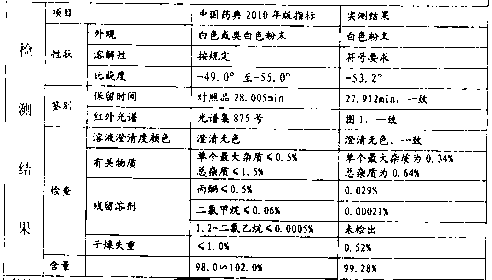Method for extracting paclitaxel from taxus chinensis branch and leaf
A technology of yew branches and leaves, paclitaxel, applied in the direction of organic chemistry, can solve the problems of low extraction efficiency, unsatisfactory purification effect, unsuitable paclitaxel, etc., and achieve the effect of reducing extraction cost, complete separation and easy operation
- Summary
- Abstract
- Description
- Claims
- Application Information
AI Technical Summary
Problems solved by technology
Method used
Image
Examples
Embodiment 1
[0025] The present invention comprises the following steps:
[0026] 1). At room temperature, crush 1000kg of yew branches and leaves in 5m 3 Soak in methanol water for 10 hours, the concentration of methanol water is 80%; filter the soaking solution at a filtration rate of 1m 3 / h, about 23h when filtering;
[0027] 2). The filtrate obtained in step 1) is filtered and decolorized by an activated carbon column. The diameter of the activated carbon column is 790mm, and the weight of the activated carbon of the activated carbon column is 80kg;
[0028] 3). Concentrate the decolorized solution obtained in step 2) under reduced pressure, the temperature condition of the reduced pressure concentration is 70°C, and the volume is concentrated to 1.8m 3 , reclaiming methanol, the reclaimed methanol can be reused after blending; using chloroform to extract the product obtained by concentrating under reduced pressure 4 times, about 400L each time, and the extracts obtained by each ext...
Embodiment 2
[0040] The present invention comprises the following steps:
[0041] 1). At room temperature, crush 1000kg of yew branches and leaves in 5m 3 Soak in methanol water for 11 hours, the concentration of methanol water is 90%; filter the soaking solution at a filtration rate of 1.2m 3 / h, about 21h when filtering;
[0042] 2). The filtrate obtained in step 1) is filtered and decolorized with an activated carbon column. The diameter of the activated carbon column is 870mm, and the weight of the activated carbon of the activated carbon column is 55kg;
[0043] 3). Concentrate the decolorized liquid obtained in step 2) under reduced pressure. 3 , reclaiming methanol, the reclaimed methanol can be reused after blending; using chloroform to extract the product obtained by concentrating under reduced pressure 4 times, about 400L each time, and the extracts obtained by each extraction are combined;
[0044] 4). The extract obtained in step 3) is recovered under normal pressure at a te...
Embodiment 3
[0051] The present invention comprises the following steps:
[0052] 1). At room temperature, crush 1000kg of yew branches and leaves in 5m 3 Soak in methanol water for 12 hours, the concentration of methanol water is 75%; filter the soaking solution at a filtration rate of 0.8m 3 / h, the filter time is 25h;
[0053] 2). The filtrate obtained in step 1) is filtered and decolorized with an activated carbon column. The diameter of the activated carbon column is 800mm, and the weight of the activated carbon of the activated carbon column is 68kg;
[0054] 3). Concentrate the decolorized solution obtained in step 2) under reduced pressure. The temperature condition of the reduced-pressure concentration is 60°C, and the volume is concentrated to 1.2m 3 , reclaiming methanol, the reclaimed methanol can be reused after blending; using chloroform to extract the product obtained by concentrating under reduced pressure 4 times, about 400L each time, and the extracts obtained by each e...
PUM
| Property | Measurement | Unit |
|---|---|---|
| diameter | aaaaa | aaaaa |
| diameter | aaaaa | aaaaa |
| diameter | aaaaa | aaaaa |
Abstract
Description
Claims
Application Information
 Login to View More
Login to View More - R&D
- Intellectual Property
- Life Sciences
- Materials
- Tech Scout
- Unparalleled Data Quality
- Higher Quality Content
- 60% Fewer Hallucinations
Browse by: Latest US Patents, China's latest patents, Technical Efficacy Thesaurus, Application Domain, Technology Topic, Popular Technical Reports.
© 2025 PatSnap. All rights reserved.Legal|Privacy policy|Modern Slavery Act Transparency Statement|Sitemap|About US| Contact US: help@patsnap.com

